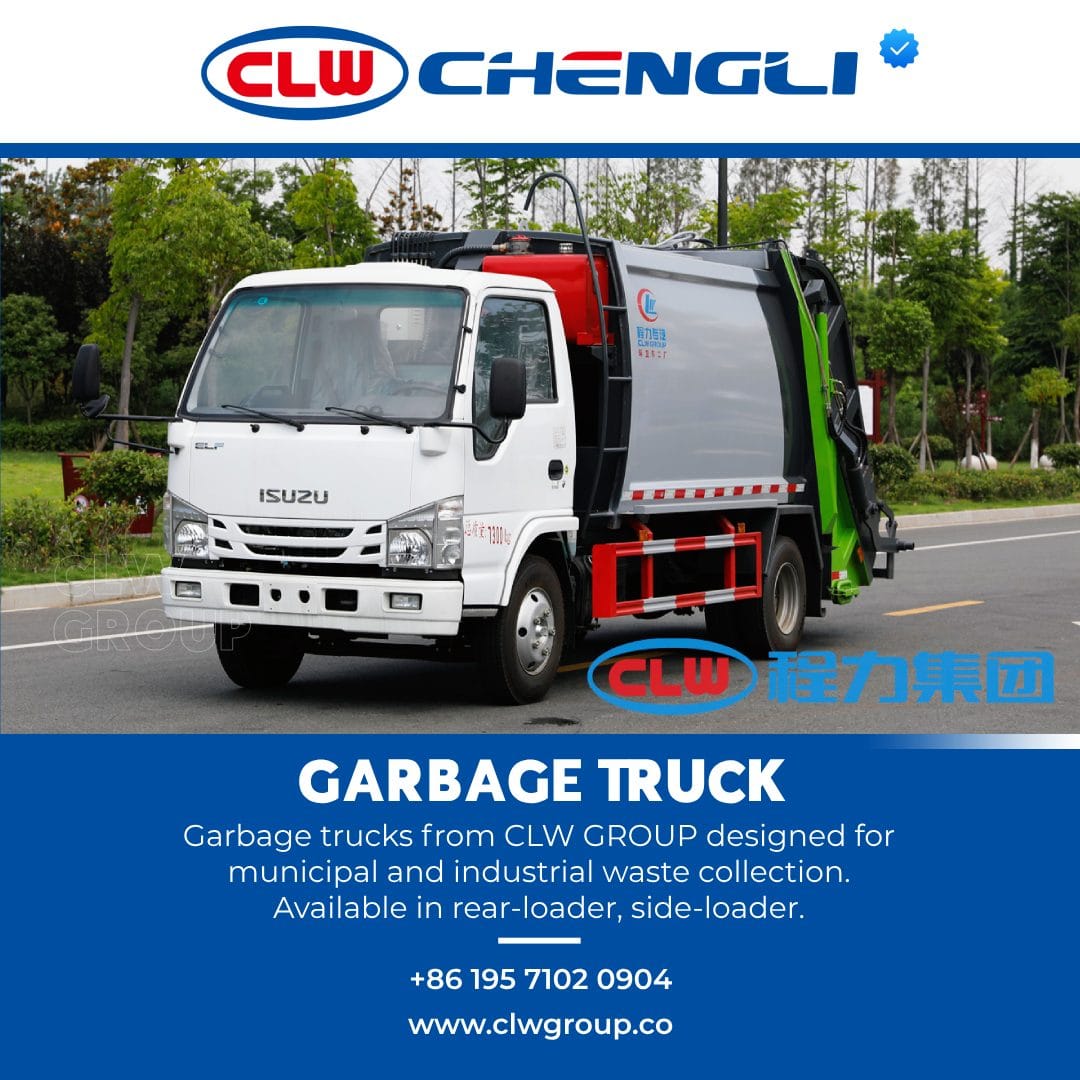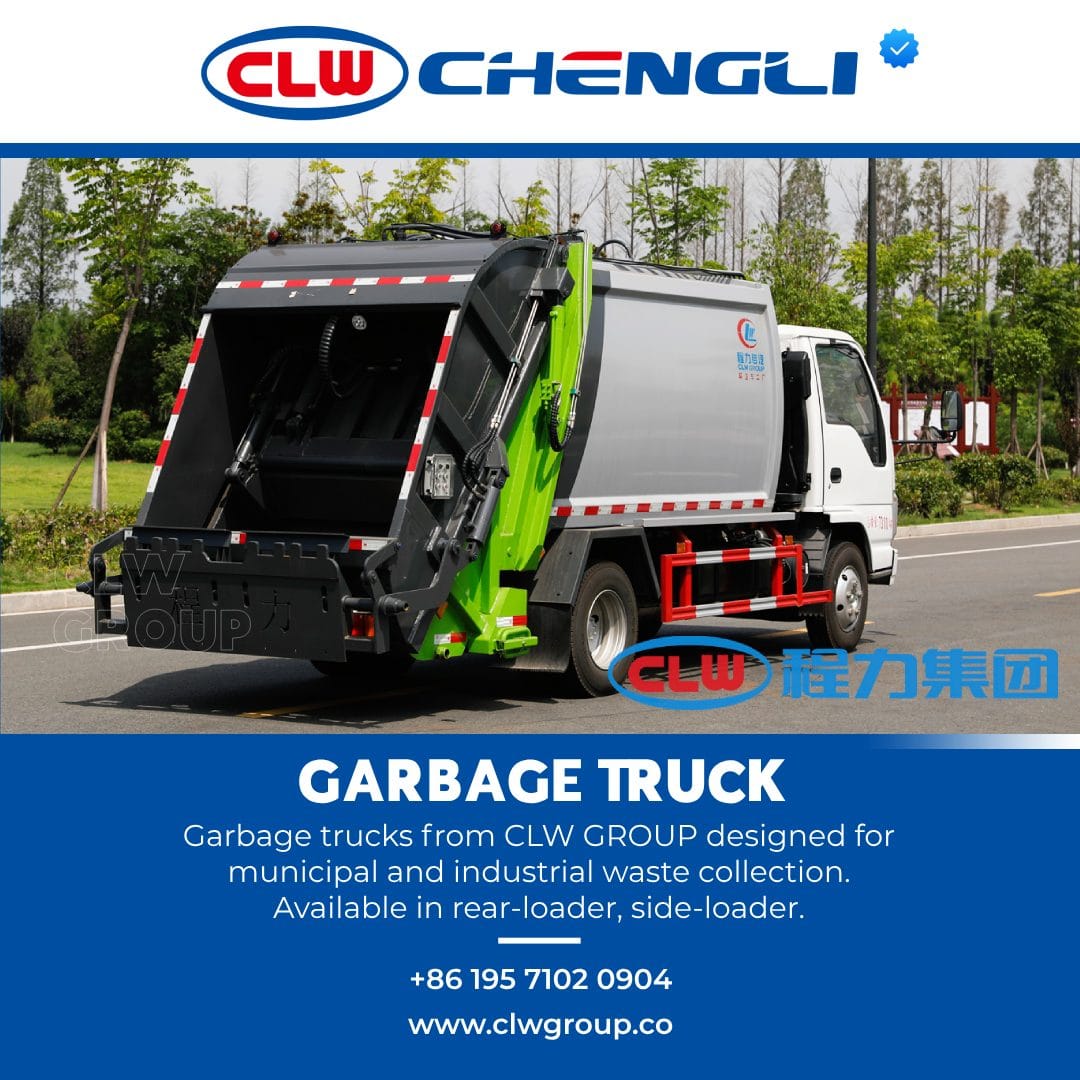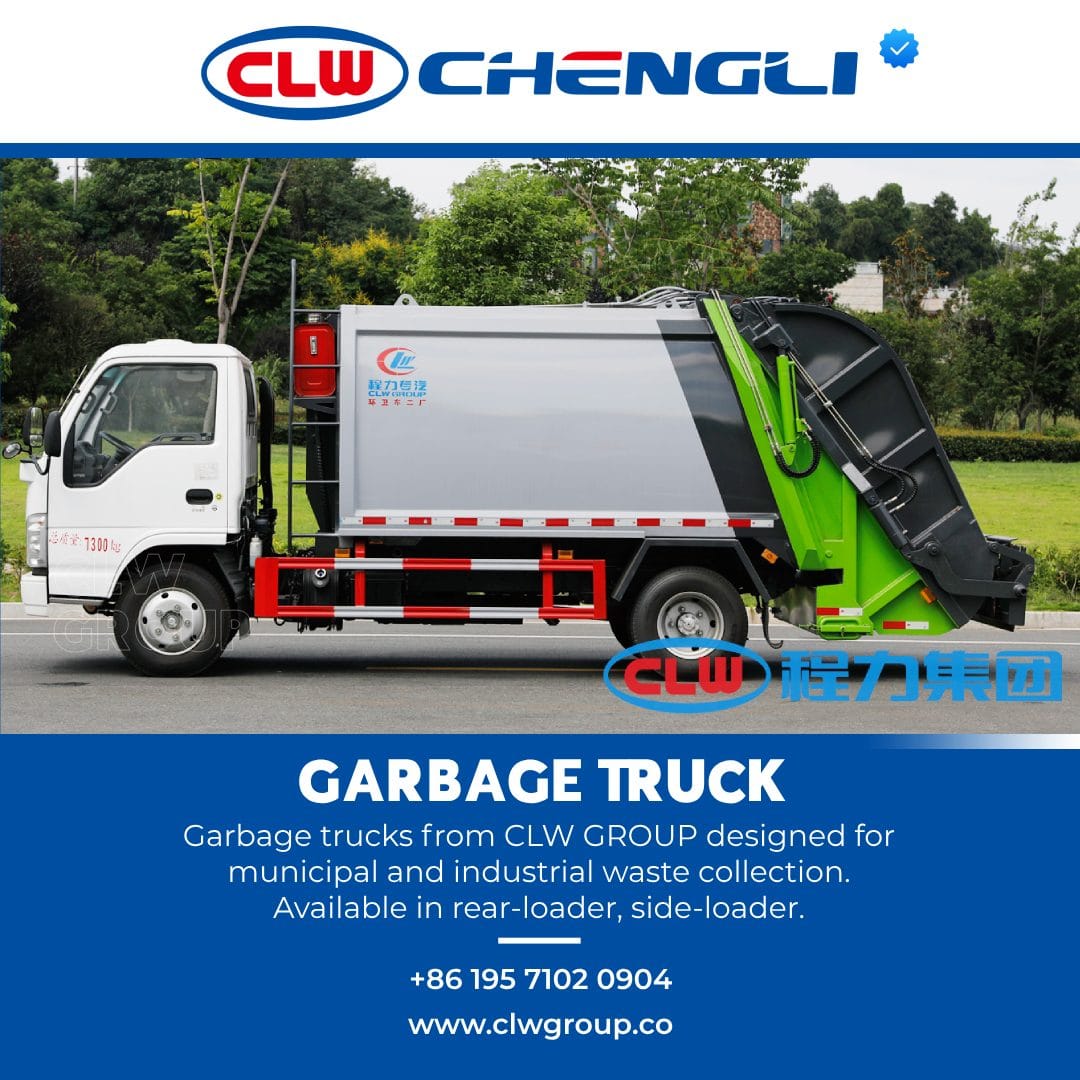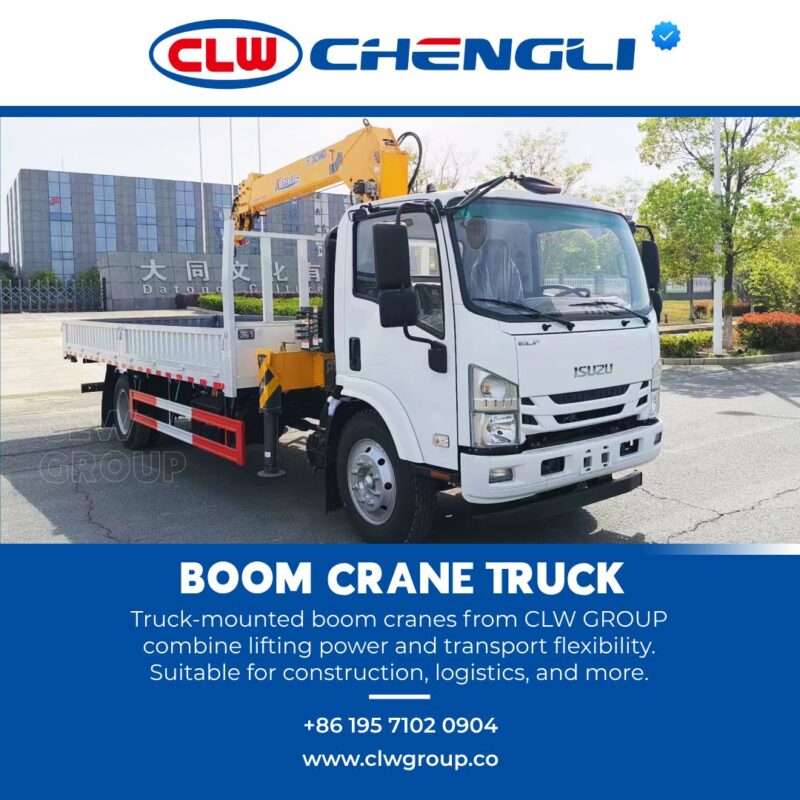Garbage Truck / Refuse Collection Vehicle – Rear, Side & Hook Lift Options
Garbage trucks from CLW GROUP designed for municipal and industrial waste collection. Available in rear-loader, side-loader, and hook-lift models with compacting systems and chassis from Dongfeng, Sinotruk, FAW, and Isuzu.
Clean Streets, Strong Systems
CLW GROUP Garbage Trucks are built for efficient, safe, and hygienic waste collection in cities, towns, and industrial zones. With options for rear-loading, side-loading, and hook-lift systems, these trucks feature high compression ratios, strong steel bodies, and user-friendly hydraulic controls.
Key Features:
✔️ Available as rear loader, side loader, or hook lift
✔️ Waste capacity from 5 to 20 cubic meters
✔️ Compression ratio up to 1:4
✔️ Hydraulic tailgate, bin lifters, and sealing system
✔️ Chassis options from CLW, Dongfeng, Isuzu, FAW, Sinotruk
Durable, reliable, and easy to operate — these refuse trucks are trusted by sanitation departments across the globe.
Technical specifications:
| Specification | Details |
|---|---|
| Chassis Brand | CLW, Isuzu, Sinotruk, Sitrak, HOWO, Shacman, Dongfeng, FAW, Foton, Beiben, JAC, JMC |
| Drive Type | 4×2, 6×4, 8×4 |
| Body Capacity | 5 – 20 cubic meters |
| Loading Type | Rear / Side / Hook Lift |
| Compaction Ratio | Up to 1:4 |
| Control System | Manual / Electric / Remote (optional) |
| Sealing Mechanism | Full rear seal with anti-drip gate |
| Additional Features | Bin lifters, rear camera, handwash tank |
Garbage Truck / Refuse Collection Vehicle – Rear, Side & Hook Lift Options
Garbage trucks, also known as refuse collection vehicles or trash trucks, play an essential role in modern sanitation by collecting, transporting, and disposing of municipal solid waste and recycling materials. These specialized vehicles are not just trucks—they are the backbone of urban cleanliness and waste management logistics. This detailed informational guide will explore every aspect of garbage trucks, from rear loaders to side-lift systems, simulation games to real-world applications, and everything in between.
Introduction to Garbage Trucks
A garbage truck is a truck specially designed for collecting waste, trash, recycling, and rubbish. These vehicles are commonly seen on urban and suburban streets, collecting refuse from residential, commercial, and industrial locations. Their primary role is to facilitate the collection and disposal of solid waste efficiently and hygienically.
Evolution of Garbage Truck Design
Modern garbage trucks have evolved significantly over the decades. From manual collection systems to high-tech automation, manufacturers now design trash trucks with precision engineering, enhanced safety, and sustainability in mind. Companies like Heil, a leader in refuse truck manufacturing, have revolutionized the refuse collection vehicle by introducing hydraulic compactor systems, rear load garbage truck innovations, and options tailored to city-specific needs.
Major Types of Garbage Trucks
There are several major types of garbage trucks, each with its unique functionality, design, and intended use.
Rear Load Garbage Truck
The rear load garbage truck is one of the most common styles. Waste collectors manually load the rubbish into a hopper at the rear of the vehicle. A hydraulic press system then compacts the waste, allowing for efficient fill and transport.
Side Load Garbage Truck
Side loaders are typically used in residential neighborhoods. These can be manually loaded or equipped with mechanical arms for automated lifting of bins. Side-lift options provide flexibility and safety for operators.
Front Load Garbage Truck
Primarily used for commercial collection, front loaders have automated forks that lift large containers over the cab of the truck and empty them into the compactor.
Hook Lift Garbage Truck
These trucks are capable of picking up containers or bins placed on the ground. They are ideal for bulk waste, construction debris, and situations requiring a flexible collection schedule.
Components and Mechanisms of a Trash Truck
Understanding the components of a garbage truck gives insight into how these machines work under demanding street and city conditions.
Compactor System
The compactor is the heart of the truck. It compresses waste to maximize fill capacity and reduce transport frequency. Compactors must handle both light and heavy materials without compromising build quality.
Hydraulic System
Hydraulic pumps and pistons drive many of the trash truck operations, including lifting bins and compacting refuse. A strong hydraulic system ensures service reliability and long-term performance.
Safety Features
Modern garbage trucks include safety sensors, rear cameras, and side-warning systems to protect operators and pedestrians. Ergonomic design and low-step entries are standard in many models.
Garbage Truck Simulator and Industry Awareness
For those interested in understanding the operation without real-world risks, garbage truck simulator games—especially on Steam and other 3D platforms—provide interactive ways to explore garbage and recycling logistics. These simulations help promote career awareness and introduce players to refuse collection concepts.
Trash Truck Use Cases in the Real World
Municipal Waste Collection
Cities rely on garbage trucks for scheduled collection routes, typically organized by sanitation departments or councils. The route and type of truck used depend on population density and street layout.
Commercial and Industrial Waste
Larger trash trucks, particularly front-loaders and hook-lift models, are used in industrial parks and commercial centers. These can handle larger volumes of solid waste, construction debris, and recyclables.
Specialized Services
Some companies offer tailored product options like rear loaders with recycling separators or compactors for food waste. Specialized trucks may have automation, cleaning, or metal sorting capabilities.
Popular Garbage Truck Brands and Manufacturers
Several manufacturers produce high-quality garbage trucks with varying configurations and technical specifications:
Heil – Known for durable rear loaders and automated side loaders
Mack Trucks – Trusted for heavy-duty configurations
Dennis Eagle – European brand known for wide cabs and low-entry design
Shacman – Provides flexible, export-grade garbage trucks to global markets
Garbage Truck Configurations and Customization
Garbage trucks can be built in a variety of formats depending on regional needs:
Chassis and Cab
Available in 8×4, 6×4, and 4×2 truck formats, the chassis can accommodate various body types depending on terrain, payload, and maneuverability.
Lift and Dump Mechanisms
Common types include hydraulic lifts, hook lifts, and compactor presses. Customization ensures proper compatibility with the bins used in that region.
Electric vs Diesel
Manufacturers are now introducing electric garbage trucks, reducing emissions and offering quiet operation in residential zones. However, diesel-powered options remain dominant in heavy-load sectors.
Garbage Truck Maintenance and Service
Proper maintenance is crucial to ensure continuous operation and safety:
Hydraulic inspections
Compactor system cleaning
Engine and transmission maintenance
Regular route data checks for fuel and efficiency
Technical Specifications to Consider
Payload and Volume
The typical garbage truck holds 6 to 30 cubic meters of waste, depending on its type and configuration.
Compaction Ratio
A good compactor should offer a 4:1 compaction ratio or better for efficient solid waste management.
Build and Materials
Trucks use wear-resistant, high-tensile steel to handle abrasion from daily operations. Internals are designed to resist corrosion from wet and acidic waste.
Future Trends in Garbage Truck Industry
Automation and Data Integration
More garbage trucks are now equipped with GPS tracking, real-time route updates, and data collection systems for improved customer service and operational efficiency.
Robotics and AI
Emerging models may use robotic arms, bin detection sensors, and AI to improve fill ratios and optimize pickups.
Sustainability Focus
Electric garbage trucks are slowly being adopted, especially in cities aiming to reduce emissions. Companies are offering high-quality green products with long durability.
Garbage Truck Game Culture
Garbage trucks have entered popular culture through 3D games and simulators, like:
Garbage Truck Simulator (Steam) – A real-time vehicle operation game
Trash Truck (Netflix) – A children’s animation promoting waste awareness
These games educate users about refuse collection, clean cities, and waste industry logistics through interactive gameplay.
Requesting and Purchasing a Garbage Truck
When looking for a garbage truck for sale, consider:
The type of collection (rear, side, front, hook-lift)
The payload capacity
Manufacturer reputation (e.g., Heil, Shacman)
Customization options like hook lifts, compactors, or rear loaders
Always ask for a technical brochure and request a quote based on your route and waste needs.
CLW Group also produces a robust cement mixer truck engineered for efficient and reliable concrete transport and mixing in construction projects.Conclusion
The garbage truck industry is a vital component of urban cleanliness, public health, and environmental safety. Whether you’re a collector, a municipality, or a curious reader exploring garbage truck simulators, understanding the core features, models, and operational mechanics of these vehicles provides clarity on how waste is managed around the world.
From rear load garbage trucks to hook-lift systems, and from 3D game simulations to real-world refuse collection, the trash truck remains a symbol of urban functionality and civic responsibility.
You must be logged in to post a review.












Reviews
There are no reviews yet.